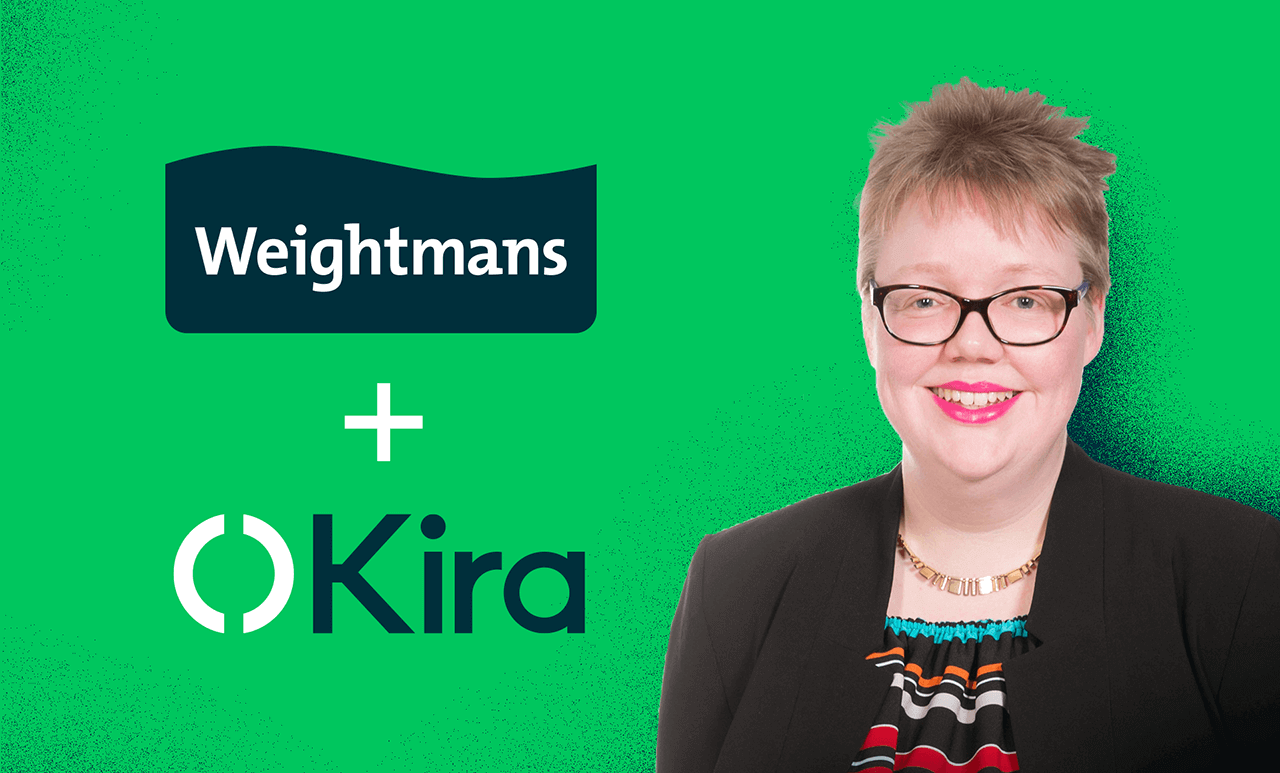Osler is a leading business law firm practising internationally from offices across Canada and in New York. The firm’s clients include industry and business leaders in all segments of the market and at various stages in the growth of their businesses.
Osler has been at the forefront of innovative service delivery. Focused on corporate and commercial transaction support, Osler Works - Transactional, a captive ALSP, leverages the expertise of a multidisciplinary team and cutting-edge technology to create customized legal solutions for high volume work that is integral to complex transactions. Kira Systems plays a critical role in the end-to-end legal due diligence offering that OWT provides to clients.
We had a Zoom call with Natalie Munroe, Head of Osler Works — Transactional, to understand how the COVID-19 pandemic has impacted the legal industry, the tools put in place to stay resilient despite very difficult times, and key learnings as the firm shifted to work from home protocol.
Use Case
Contract Review: M&A, Capital Markets, Lease Abstraction, Commercial (Franchise and Technology), Banking, Deal Points, Compliance and Entity Management
Site
About
Founded in 1862
Headquartered in Toronto
What is your role at Osler?
I am the Head of Osler Works — Transactional, a multidisciplinary team based in Ottawa and Toronto that is focused on corporate and commercial transaction support. We partner our expertise with cutting-edge technology, including Kira Systems, to create customized legal solutions for our clients for high volume work that is integral to complex transactions. We are fully integrated with deal teams in our corporate and commercial practices in all of the Osler offices and provide services such as end-to-end legal due diligence, generation and negotiation of documents for high volume transactions, virtual closings, document automation and compliance and entity management.
How did you identify the need for contract review software prior to the pandemic?
For several years, the legal industry has been undergoing significant change. Three years ago, we launched OWT to transform the way we provide some corporate and commercial transactional legal services to our clients to proactively respond to the changing legal industry.
We began by analyzing the lifecycle of a typical transaction to figure out our own pressure points and to determine which of such points aligned with known pain points of our clients. Due diligence is a critical component of most transactions, but it is no secret that it can be time-consuming and costly for clients. As we began to transform how we conduct due diligence in the context of corporate and commercial transactions, we began to monitor the market for software that could help us enhance our due diligence. We explored a number of software options and piloted Kira when it was new to the market. As we began to use Kira, it quickly became apparent that partnered with the expertise of a multidisciplinary team, it would dramatically transform how we conduct due diligence.
Kira continues to be an integral part of how we conduct due diligence for corporate and commercial transactions. We continue to look at Kira from a quality perspective and have expanded our use cases to include, for example, lease abstractions for landlords for multiple purposes (including high volume estoppel certificates as part of our Estoppel Express product), deal points for a number of industries and clients (as well as ourselves), abstractions of franchise documents, technology risk analysis and compliance and entity management.
From interruptions in supply chains to challenges in meeting contractual obligations, what are some legal implications that Osler is helping clients with?
We ensured that our clients’ complex transactions - initiated either pre or post-pandemic - could move forward to meet their business goals and obligations by using cross-functional teams from home through shared data rooms, remote due diligence review and virtual closings. These were supported by a variety of legal tech like Closing Folders, HighQ, DocuSign and virtual conferencing tools like GoToMeeting and Pexip.
Sample clients whose deals we supported over this period include:
- WealthBar - CI Financial Corp. in the acquisition of a 25% equity stake
- Insightful Science completed its acquisition of Cytapex Bioinformatics completely virtually
- Ritual in Series D Funding
- ApplyBoard in its CAD $100 million Series C financing round
- Atomic Loans in its $3.4 million Seed Funding
- PocketHeath in its US$6.5 million financing round
- Skyline Commercial REIT in its acquisition of a four-property industrial portfolio
We helped our litigation clients keep their disputes moving by providing, hosting and supporting virtual discoveries, cross-examinations, motions and other hearings. As the courts open more and more proceedings to remote hearings, we have also adapted our training on remote technologies and remote advocacy, anticipating that we may see permanent changes to the ways in which cases are heard. While not strictly pandemic related, in one of our first applications of Kira for litigation purposes, we are helping our Osler Works Disputes team build their predictive analytics database to assist them in making stronger data-informed decisions.
We are working with our leasing clients and using Kira to conduct force majeure focused reviews of lease portfolios, and to provide quick analysis of landlord and tenants’ contractual rights and obligations in the face of the pandemic.
We built our COVID-19 online resource and subscription service to assist our clients in navigating – in a self-help format - the span of legal issues related to COVID-19.
How is the firm monitoring COVID-19 developments and sharing insights related to legal and business considerations to help clients?
In March we established our COVID-19 resource page so that our lawyers could quickly and easily share timely insights with our clients. The site also provides for a daily subscription for new content sharing and we have over 1100 subscribers to this content. In this resource hub, we have shared over 100 specific resources in over 30 business areas. We are continually adding to the site as the situation changes. Since its first publication, the page has garnered over half a million unique pageviews, averaging over 30,000-45,000 unique pageviews per week.
We also created a centralized internal communications site to help support and streamline advice and resources for our clients, as well as to support our own lawyers and staff. These are updated by our knowledge management, innovation, and library service teams who ensure we are all kept up to date on legislative changes and new information.
We have also developed a number of COVID-19 related CPD accredited webinars and other program offerings. Client interest in and attendance for these CPD offerings has been high. For instance, our return to the workplace webinar attracted approximately 700 people who accepted the invitation and resulted in a 74% attendance rate, and our recent AccessPrivacy call attracted 650 who accepted the invitation and resulted in a 66% attendance rate.
Our knowledge management, innovation, and library service teams have been working with lawyers to stay up to date on all legislative changes and information relevant to our clients in order to generate the key content that fuels our various resource pages and CPD offerings.
How did the firm shift to work from home protocol? What tools have been leveraged to assist with remote working and business continuity?
Through the work of our leadership and our Information Systems department, we were able to ensure that the firm had the infrastructure set up to support the over 1000+ firm members across six offices working remotely within ten days. They did amazing work behind the scenes to ensure our team had the right equipment, training, and security to work virtually. They kept us opening matters, doing conflicts checks, applying ethical walls, while helping us with technology questions and issues at the same time.
We were well prepared in that many of the technologies we use to help advise our clients were in place before the pandemic, including many of the products and processes we use as part of Osler Works. Many of these products and processes we developed in house to help automate and streamline processes for transactions, disputes, franchises, real estate, and employment.
We use a suite of software, including of course Kira, that helps facilitate client business activities, such as closings (through Closing Folders) and the exchange of signatures (through DocuSign), without the need for in-person meetings.
We transitioned all our client meetings and special events to on-line formats, using video conference and webinar technologies such as GoToMeeting and Pexip, and Microsoft Teams for internal meetings. We have technicians who assist to ensure that meetings run smoothly.
What have been some key learnings on how to effectively make an entire law firm work from home? Any advice that you would like to share with peers?
Communications and staying connected is key, both from a business and a social perspective. Early on, we rolled out Microsoft Teams firm-wide to provide resources for internal meetings and conversations. While the firm recognized the need for increased functionality from a business perspective, it also made the choice to create and support Osler Ensemble, a set of social channels on Microsoft Teams which help connect people within offices, practice groups, teams, and across interest groups. It also includes channels for parents and caregivers, and channels for fitness suggestions. These social channels help to translate the culture of our firm to the remote work environment.
From an operational perspective, technology and its effective implementation were key in relocating our firm to our home offices.
Working effectively together often means quickly pivoting and learning where to deploy your team where it is most needed. Sometimes that means team members stepping up to learn new skills or to help address issues they may not have encountered before. After the volume of calls to our IT service desk tripled as we moved to our remote work environment, we redeployed members of our tech training team to help manage the transition. As well, our Legal Talent and HR teams developed new processes to virtually on-board new lawyers and staff. This included building a more robust Learning Management System for training modules.



